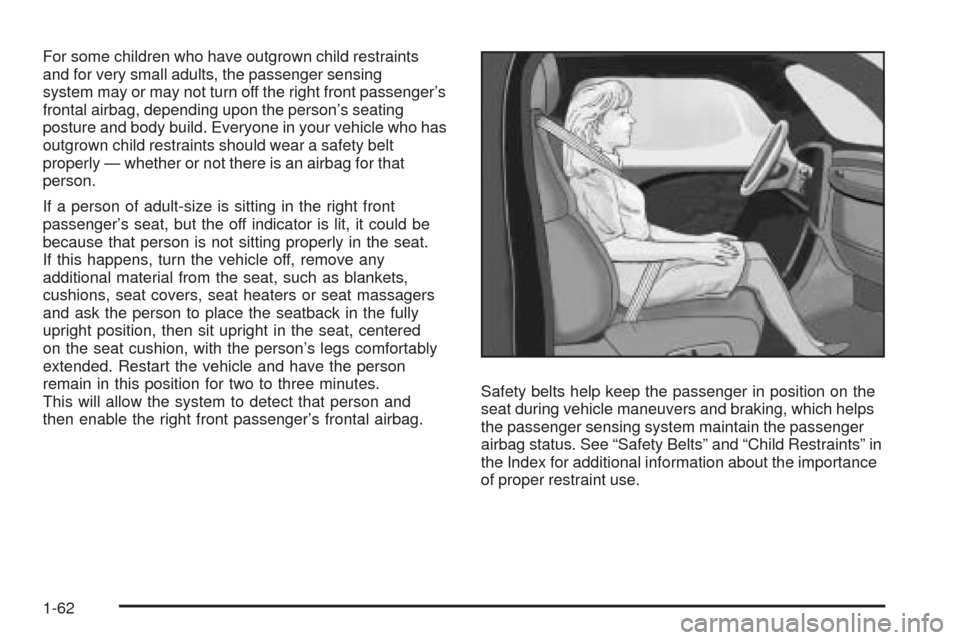2009 CADILLAC STS heater
[x] Cancel search: heaterPage 65 of 514

The passenger sensing system is designed to turn off
the right front passenger’s frontal airbag if:
The right front passenger seat is unoccupied.
The system determines that an infant is present in a
rear-facing infant seat.
The system determines that a small child is present
in a child restraint.
The system determines that a small child is present
in a booster seat.
A right front passenger takes his/her weight off of the
seat for a period of time.
The right front passenger seat is occupied by a
smaller person, such as a child who has outgrown
child restraints.
Or, if there is a critical problem with the airbag
system or the passenger sensing system.
When the passenger sensing system has turned off the
right front passenger’s frontal airbag, the off indicator
will light and stay lit to remind you that the airbag is off.
SeePassenger Airbag Status Indicator on page 3-59.
If a child restraint has been installed and the on indicator
is lit, turn the vehicle off. Remove the child restraint
from the vehicle and reinstall the child restraint followingthe child restraint manufacturer’s directions and refer to
Securing a Child Restraint in the Right Front Seat
Position on page 1-47.
If, after reinstalling the child restraint and restarting the
vehicle, the on indicator is still lit, check to make sure that
the vehicle’s seatback is not pressing the child restraint
into the seat cushion. If this happens, slightly recline
the vehicle’s seatback and adjust the seat cushion if
possible. Also make sure the child restraint is not trapped
under the vehicle head restraint. If this happens, adjust
the head restraint. SeeHead Restraints on page 1-5.
Remove any additional material from the seat such as
blankets, cushions, seat covers, seat heaters, or seat
massagers before reinstalling or securing the child
restraint.
If the on indicator is still lit, secure the child in the child
restraint in a rear seat position in the vehicle, and check
with your dealer/retaier.
The passenger sensing system is designed to enable
(may in�ate) the right front passenger’s frontal airbag
anytime the system senses that a person of adult size is
sitting properly in the right front passenger’s seat. When
the passenger sensing system has allowed the airbag to
be enabled, the on indicator will light and stay lit to remind
you that the airbag is active.
1-61
Page 66 of 514

For some children who have outgrown child restraints
and for very small adults, the passenger sensing
system may or may not turn off the right front passenger’s
frontal airbag, depending upon the person’s seating
posture and body build. Everyone in your vehicle who has
outgrown child restraints should wear a safety belt
properly — whether or not there is an airbag for that
person.
If a person of adult-size is sitting in the right front
passenger’s seat, but the off indicator is lit, it could be
because that person is not sitting properly in the seat.
If this happens, turn the vehicle off, remove any
additional material from the seat, such as blankets,
cushions, seat covers, seat heaters or seat massagers
and ask the person to place the seatback in the fully
upright position, then sit upright in the seat, centered
on the seat cushion, with the person’s legs comfortably
extended. Restart the vehicle and have the person
remain in this position for two to three minutes.
This will allow the system to detect that person and
then enable the right front passenger’s frontal airbag.Safety belts help keep the passenger in position on the
seat during vehicle maneuvers and braking, which helps
the passenger sensing system maintain the passenger
airbag status. See “Safety Belts” and “Child Restraints” in
the Index for additional information about the importance
of proper restraint use.
1-62
Page 67 of 514

{CAUTION:
If the airbag readiness light in the instrument panel
cluster ever comes on and stays on, it means that
something may be wrong with the airbag system.
If this ever happens, have the vehicle serviced
promptly, because an adult-size person sitting in
the right front passenger’s seat may not have the
protection of the airbag(s). SeeAirbag Readiness
Light on page 3-58for more on this, including
important safety information.A thick layer of additional material, such as a blanket or
cushion, or aftermarket equipment such as seat covers,
seat heaters, and seat massagers can affect how well the
passenger sensing system operates. We recommend
that you not use seat covers or other aftermarket
equipment other than any that GM has approved for
your speci�c vehicle. SeeAdding Equipment to Your
Airbag-Equipped Vehicle on page 1-64for more
information about modi�cations that can affect how
the system operates.
{CAUTION:
Stowing of articles under the passenger seat or
between the passenger seat cushion and seatback
may interfere with the proper operation of the
passenger sensing system.
1-63
Page 69 of 514

In addition, your vehicle has a passenger sensing
system for the right front passenger’s position, which
includes sensors that are part of the passenger’s
seat. The passenger sensing system may not
operate properly if the original seat trim is replaced
with non-GM covers, upholstery or trim, or with GM
covers, upholstery or trim designed for a different
vehicle. Any object, such as an aftermarket seat
heater or a comfort enhancing pad or device,
installed under or on top of the seat fabric, could also
interfere with the operation of the passenger sensing
system. This could either prevent proper deployment
of the passenger airbag(s) or prevent the passenger
sensing system from properly turning off the
passenger airbag(s). SeePassenger Sensing
System on page 1-59.
If you have any questions about this, you should
contact Customer Assistance before you modify
your vehicle. The phone numbers and addresses
for Customer Assistance are in Step Two of
the Customer Satisfaction Procedure in this manual.
SeeCustomer Satisfaction Procedure on page 7-2.Q:Because I have a disability, I have to get my
vehicle modi�ed. How can I �nd out whether this
will affect my airbag system?
A:If you have questions, call Customer Assistance.
The phone numbers and addresses for Customer
Assistance are in Step Two of the Customer
Satisfaction Procedure in this manual. See
Customer Satisfaction Procedure on page 7-2.
In addition, your dealer/retailer and the service manual
have information about the location of the airbag
sensors, sensing and diagnostic module and airbag
wiring.
1-65
Page 73 of 514

Keys...............................................................2-3
Keyless Access System...................................2-4
Keyless Access System Operation....................2-5
Remote Vehicle Start....................................2-11
Doors and Locks............................................2-13
Door Locks..................................................2-13
Power Door Locks........................................2-13
Programmable Automatic Door Locks..............2-14
Rear Door Security Locks..............................2-14
Lockout Protection........................................2-15
Trunk..........................................................2-15
Windows........................................................2-18
Power Windows............................................2-19
Sun Visors...................................................2-21
Theft-Deterrent Systems..................................2-21
Theft-Deterrent System..................................2-21
Valet Lockout Switch.....................................2-23
Immobilizer..................................................2-24
Immobilizer Operation....................................2-24Starting and Operating Your Vehicle................2-25
New Vehicle Break-In....................................2-25
Ignition Positions..........................................2-26
Retained Accessory Power (RAP)...................2-27
Starting the Engine.......................................2-27
Engine Coolant Heater..................................2-29
Automatic Transmission Operation...................2-30
Parking Brake..............................................2-33
Shifting Into Park..........................................2-34
Shifting Out of Park......................................2-35
Parking Over Things That Burn.......................2-35
Engine Exhaust............................................2-36
Running the Vehicle While Parked..................2-37
Mirrors...........................................................2-38
Automatic Dimming Rearview Mirror...............
.2-38
Compass.....................................................2-38
Outside Power Mirrors...................................2-40
Outside Automatic Dimming Mirror..................2-40
Park Tilt Mirrors............................................2-41
Outside Convex Mirror...................................2-41
Outside Heated Mirrors..................................2-41
Section 2 Features and Controls
2-1
Page 101 of 514

Stopping the Engine
Move the shift lever to P (Park) and press the
Acc. button located on the instrument panel. If the
shifter is not in P (Park), the engine shuts off and the
vehicle goes into the Accessory Mode. The DIC
displays SHIFT TO PARK. Once the shifter is moved
to P (Park), the vehicle turns off.
The DIC displays NO FOB, OFF OR RUN?, if the
keyless access transmitter is not detected inside the
vehicle when it is turned off.
SeeDIC Warnings and Messages on page 3-79for
more information.
Engine Coolant Heater
The engine coolant heater can provide easier starting
and better fuel economy during engine warm-up in cold
weather conditions at or below 0°F (−18°C). Vehicles with
an engine coolant heater should be plugged in at least
four hours before starting. Some models have an internal
thermostat in the cord which will prevent engine coolant
heater operation at temperatures above 0°F (−18°C).
To Use the Engine Coolant Heater
1. Turn off the engine.
2. Open the hood and unwrap the electrical cord.
For the 3.6L V6 and 4.4L V8 engine, the cord is
located in the front of the engine compartment,
on the passenger side of the vehicle.
For the 4.6L V8 engine, the cord is located in the
engine compartment on the driver side of the vehicle
near the inner fender and above the strut.
3. You must remove the plastic cap to access
the plug.
4. Plug it into a normal, grounded 110-volt AC outlet.
{CAUTION:
Plugging the cord into an ungrounded outlet could
cause an electrical shock. Also, the wrong kind of
extension cord could overheat and cause a �re.
You could be seriously injured. Plug the cord into a
properly grounded three-prong 110-volt AC outlet.
If the cord will not reach, use a heavy-duty
three-prong extension cord rated for at least
15 amps.
2-29
Page 102 of 514

5. Before starting the engine, be sure to unplug and
store the cord as it was before to keep it away
from moving engine parts. If you do not, it could
be damaged.
The length of time the heater should remain plugged
in depends on several factors. Ask a dealer/retailer
in the area where you will be parking the vehicle for
the best advice on this.
Automatic Transmission Operation
There are several different
positions for the shift lever.
P (Park):This position locks the rear wheels. It is the
best position to use when you start the engine because
the vehicle cannot move easily.
{CAUTION:
It is dangerous to get out of the vehicle if the shift
lever is not fully in P (Park) with the parking brake
�rmly set. The vehicle can roll.
Do not leave the vehicle when the engine is
running unless you have to. If you have left the
engine running, the vehicle can move suddenly.
You or others could be injured. To be sure the
vehicle will not move, even when you are on fairly
level ground, always set the parking brake and
move the shift lever to P (Park). SeeShifting Into
Park on page 2-34. If you are pulling a trailer,
seeTowing a Trailer (Vehicles Without Heavy
Duty Cooling) on page 4-31orTowing a Trailer
(Vehicles With Heavy Duty Cooling) on page 4-32.
Make sure the shift lever is fully in P (Park)
before starting the engine. The vehicle has an
automatic transmission shift lock control system.
You must fully apply your regular brakes �rst and
then press the shift lever button before you can
shift from P (Park) when the vehicle is running.
2-30
Page 352 of 514

Cooling System
The cooling system allows the engine to maintain the
correct working temperature.
A. Electric Engine Cooling Fan(s) (Out of view)
B. Mechanical Engine Cooling Fan (If equipped)
(Out of view)
C. Coolant Surge Tank and Pressure Cap{CAUTION:
An electric engine cooling fan under the hood can
start up even when the engine is not running and
can cause injury. Keep hands, clothing, and tools
away from any underhood electric fan.
{CAUTION:
Heater and radiator hoses, and other engine parts,
can be very hot. Do not touch them. If you do, you
can be burned.
CAUTION: (Continued)
3.6L V6 Engine shown, 4.6L V8 and
4.4L V8 STS-V Engines similar
5-26